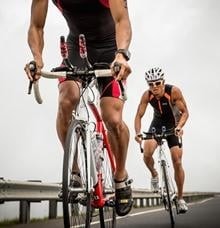The famous Ironman triathlon that takes place each year on the Big Island of Hawaii consists of a 2.4-mile swim, a 112-mile bike ride and a 26.2-mile run.
Well, aspiring athlete, don't despair! Triathlons come in a variety of distances shorter than the Ironman, and these have become very popular with those looking to challenge themselves without such a daunting commitment.
Here's a look at your shorter options:
Sprint: Great for beginners, Sprints consist of a 0.24- to 0.62-mile swim, a 5- to 15.5-mile bike ride and a 1- to 3-mile run.
Olympic: This length consists of a 0.93-mile swim, a 24.8-mile bike ride and a 6.2-mile run.
Half Ironman: This features a 1.2-mile swim, a 56-mile bike ride and a 13.1-mile run—exactly half of a full Ironman.
Swimming Tips

Find a masters swim program in your area to get practice with a group and the guidance of a skilled coach. These are frequently found at YMCAs and public pools.
Practice swimming in open water before race day so you'll know what to expect—it's very different from swimming in a pool. Never swim alone and avoid areas with boat traffic.
Learn to sight on an object on the shore. As you turn your head to breathe, lift your head just slightly to see what's ahead. You'll spend less time zig-zagging and swimming into buoys during the race.
Exit your wetsuit faster with a little cooking spray applied to your calves and arms. Don't get it on your hands or you won't be able to get a grip on the suit. You can also use Bodyglide® lubricant.
Running and Cycling Tips
Do interval training. Include several short bursts of harder intensity effort in your normal workout, with recovery periods in between. This increases your body's ability to perform at a faster pace. Do no more than 1 set of running or cycling interval sessions per week as these workouts put extra stress on your body.
Run on dirt or gravel trails as they are softer underfoot than streets and sidewalks. Trails are not only less jarring, but the uneven surfaces allow more muscles in your feet and ankles to get a workout, preventing overuse that might occur when running on a totally flat, hard surface.

Do your cycle training with a group, not only for safety and help if you get a flat, but for the extra motivation and fun. If you go with faster cyclists, you're bound to pick up your speed and learn some tips from them.
Learn how to fix a flat tire quickly and easily by watching the REI Expert Advice video, How to Fix a Flat Tire. Always take along a spare tube/patch kit and a pump on your rides.
Practice doing bricks, which is the name given to the transition workout, especially from the bike to the run. Your legs will take a little while to transition to the run when you jump off your bike, so practice bike-to-run bricks a few times before your race.
Fuel and Rest
Stay hydrated to keep your body in good working order. Dehydration is a common energy zapper that is easy to overlook. Drink before you feel thirsty and be sure to get extra fluids before and after you work out. Take water or energy drinks with you on any workouts longer than a half hour.
Eata small snack about 2 hours before your workout to give you energy to perform your best. And, of course, strive to eat a healthy, balanced diet during your training period (and beyond).
Get adequate sleep and schedule in rest days to allow your body to recover from your workouts. Rest days are also vital for preventing injuries and burnout from overtraining.
Congratulations on giving a "tri" a try, and best of luck to you in your training.
